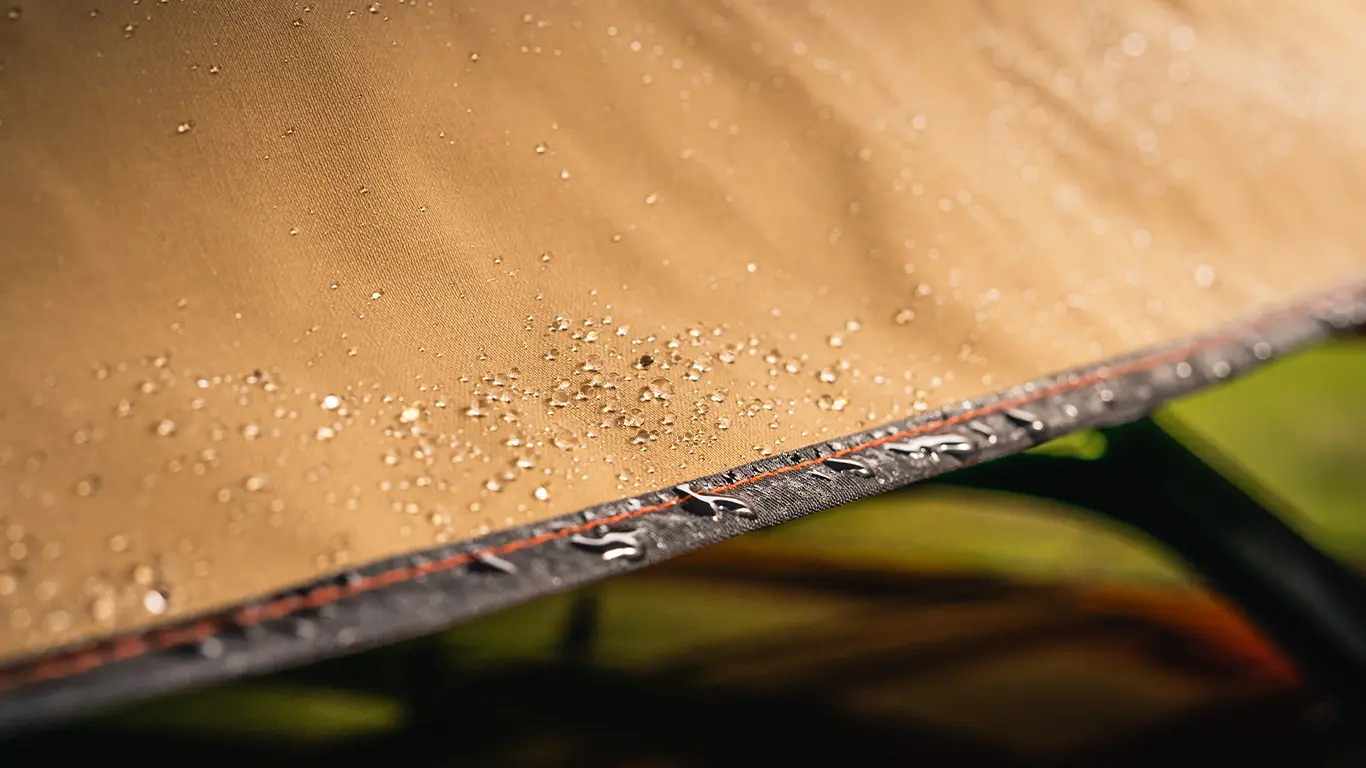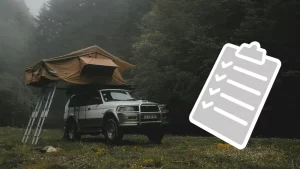It had been a relentlessly hot day with temperatures pushing extremes in a terrain bereft of any form of shadow-spending trees or structures. The awning was a blessing, but the lack of even the slightest whiff of a breeze meant that it wasn’t just hot, the whole area was a seething cauldron.
As the day drew to a close, the setting sun threw its last rays onto ominous, low-hanging clouds rolling towards me from afar. The closer they came, the lower the temperatures fell—too fast and too low for a midsummer evening. I could smell the rain minutes before it arrived. Big heavy droplets. Sporadic at first. Until that first flash of lightning ripped a gaping hole in the smothering cloud and unleashed a downpour so dense, visibility was obscured as if by heavy fog.
Nature’s wrath found no end: the soothing breeze I’d missed during the day took the stage with a roaring vengeance. North, south, east, west, it had no direction as it pummelled and tugged at the thin walls that sheltered me from the satanic elements without.
This wasn’t my first rodeo. I should have known better. I felt safe in my rooftop tent as the wild spirits outside thrashed, flashed and grumbled. All was well until…a heavy gust rolled in, beat against the side of the car, and pushed upwards. Déjà vu. In the fraction of a second before it happened, I saw the guy ropes that should have secured the folded-out floor against the brute force now heaving at it in a frantic bid to pack my tent away with me inside.
You see, weatherproofing is about all climatic conditions, and I haven’t even got to snow yet.
HEAT
If you know you’re in for a long dry spell of heat, which may not flout during the night, some tent designs allow you to remove the rain fly thus improving conditions inside the tent enormously. Every form of ventilation that allows the air inside to circulate is welcome.
In addition to the door, soft-shell tents can be fitted with windows, vents, and even skylights that can be opened. Hard-shell tents, as the name implies, have large surface areas made of solid materials that can absorb and retain heat—it doesn’t matter if they are red, white or black, they all get hot. Compared to wedge-shaped tents, the vertically opening variety have four walls, mostly with windows opening to all sides. Hybrid tents have the solid protective panel forming one end of the tent, combined with walls and part of the roof made of fabric, often fitted with vents and windows.
Some tent manufacturers also use fabrics that reflect heat efficiently.
RAIN
Water has a tendency to find its way through the tiniest of pores. Check the waterproof rating of every tent you look at. A fabric’s rating is measured in millimetres (mmH2O). This measurement does not refer to the material thickness or the coating, but to the pressure at which water can pass through. You might think that the higher the number the better. Well, yes and no. The answer lies more in the durability of the rainproofing. Whereas 1,500 mmH2O, for example, is enough to keep you dry inside when the tent is new, a higher value will keep you dry and be more adept at withstanding the rigours of regular use and frequent opening and closing of the tent, all of which can reduce the effectiveness of the waterproofing over time.
However, if the coating is too thick, then the material becomes heavy and less flexible. A figure that has proven to be effective against rain and durable in the long run is 3,000 mmH2O.
Seams are the weakest line of defence between you on the inside and the incessant downpour. Tent manufacturers use two widely accepted solutions to create a barrier and prevent droplets of water seeping through the needle holes created during sewing: sealing and taping.
Sealing, in its simplest terms, is not dissimilar to applying a waterproof coating to a seam. This is a preferred measure on ultra-lightweight tents, where the materials are extremely thin and easily scrunched up, reducing the adhesive capability of tape. However, rooftop tents do not generally fall into the ultra-light category with such super-thin materials.
Taping is exactly what the name implies: a tape (usually polyurethane) that is thermally bonded to the underside of the fabric to prevent water from permeating through the needle holes. This can only be applied efficiently at the factory.
Another welcome feature on any rooftop tent is a porch or small protruding roof to protect the entrance door from wind-driven rain.
WIND
There is a lot of theory related to best practices when the wind picks up. In reality though, it is not always possible to predict where the wind will be coming from. If you can, position your vehicle to make most use of the tent’s aerodynamics. Wedge-shaped hard-shell and hybrid tents are the best performers in these conditions. Those that open vertically have four walls that offer resistance regardless of the direction of the wind. If you are in a soft-shell tent, aerodynamics don’t really come into play either.
In all cases however, it pays to fold down, or at least minimise the size of, any porches at the door and windows.
Check all attachment points for guy ropes and make sure they are strong and secure. Also look at the general sturdiness of the structure and ask the seller if the tent has undergone any wind testing.
Some manufacturers provide additional struts to support the roof of hard-shell and hybrid models.
Noise will also play a significant role in windy conditions, and a soft-shell tent has the most material to flap.
SNOW
If you are a winter camper, then you should expect snow and anticipate its weight. Vertically opening hard-shell tents with flat roofs will have the heaviest load to bear. Wedge-shaped hard-shells and hybrid tents, however, can also have a tendency to want to close if the angle of the roof allows a thick layer of snow to accumulate.
As mentioned above, some manufacturers provide additional struts to support the roof of hard-shell and hybrid models.
Another aspect to consider, especially with hybrid and soft-shell tents, is the accumulation of snow on the fabric roof and the temperature difference between inside and outside. Anticipate a build-up of condensation and make sure to ventilate properly.
SUMMING UP or TL;DR
As a year-round camper, I like to take every precaution against adverse weather conditions.
- UV protection and a removable rain fly are good when the temperatures soar.
- Good rainproofing and watertight seams will keep me dry.
- Solid fixing points and the ability to tie down loose material will prevent the wind getting a hold.
- Additional struts can help provide additional support if there is a risk of of heavy winds or snow collecting on the roof.







